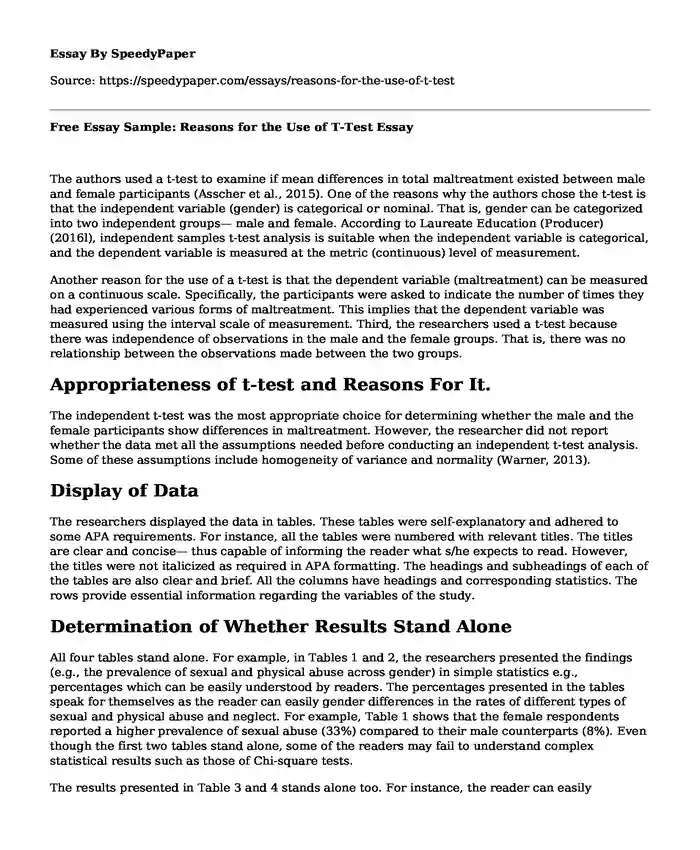
| Essay type: | Compare and contrast |
| Categories: | Gender Violence Sexes |
| Pages: | 3 |
| Wordcount: | 617 words |
The authors used a t-test to examine if mean differences in total maltreatment existed between male and female participants (Asscher et al., 2015). One of the reasons why the authors chose the t-test is that the independent variable (gender) is categorical or nominal. That is, gender can be categorized into two independent groups— male and female. According to Laureate Education (Producer) (2016l), independent samples t-test analysis is suitable when the independent variable is categorical, and the dependent variable is measured at the metric (continuous) level of measurement.
Another reason for the use of a t-test is that the dependent variable (maltreatment) can be measured on a continuous scale. Specifically, the participants were asked to indicate the number of times they had experienced various forms of maltreatment. This implies that the dependent variable was measured using the interval scale of measurement. Third, the researchers used a t-test because there was independence of observations in the male and the female groups. That is, there was no relationship between the observations made between the two groups.
Appropriateness of t-test and Reasons For It.
The independent t-test was the most appropriate choice for determining whether the male and the female participants show differences in maltreatment. However, the researcher did not report whether the data met all the assumptions needed before conducting an independent t-test analysis. Some of these assumptions include homogeneity of variance and normality (Warner, 2013).
Display of Data
The researchers displayed the data in tables. These tables were self-explanatory and adhered to some APA requirements. For instance, all the tables were numbered with relevant titles. The titles are clear and concise— thus capable of informing the reader what s/he expects to read. However, the titles were not italicized as required in APA formatting. The headings and subheadings of each of the tables are also clear and brief. All the columns have headings and corresponding statistics. The rows provide essential information regarding the variables of the study.
Determination of Whether Results Stand Alone
All four tables stand alone. For example, in Tables 1 and 2, the researchers presented the findings (e.g., the prevalence of sexual and physical abuse across gender) in simple statistics e.g., percentages which can be easily understood by readers. The percentages presented in the tables speak for themselves as the reader can easily gender differences in the rates of different types of sexual and physical abuse and neglect. For example, Table 1 shows that the female respondents reported a higher prevalence of sexual abuse (33%) compared to their male counterparts (8%). Even though the first two tables stand alone, some of the readers may fail to understand complex statistical results such as those of Chi-square tests.
The results presented in Table 3 and 4 stands alone too. For instance, the reader can easily understand the strength and direction of the relationship between variables in Table 3. Similarly, in Table 4, the reader can see the extent to which the predictor variable predicts the outcome variable.
Effect size and meaningfulness
The authors presented the effect sizes in Tables 1 and 2. Most of the effect sizes were meaningful as they were between small (0.2) and a large effect size of 0.8 (Day et al., 2014).
References
Asscher, J. J., Van der Put, C. E., & Stams, G. J. J. M. (2015). Gender differences in the impact of abuse and neglect victimization on adolescent offending behavior. Journal of Family Violence, 30(2), 215–225. https://doi.org/10.1007/s10896-014-9668-4
Day, L., Maltby, J., & Williams, G. (2014). Introduction to statistics for nurses. Routledge.
Laureate Education (Producer). (2016l). The t test for independent samples [Video file]. Baltimore, MD: Author.
Warner, R. M. (2013). Applied statistics: From bivariate through multivariate techniques: from bivariate through multivariate techniques. SAGE.
Cite this page
Free Essay Sample: Reasons for the Use of T-Test. (2023, Sep 26). Retrieved from https://speedypaper.com/essays/reasons-for-the-use-of-t-test
Request Removal
If you are the original author of this essay and no longer wish to have it published on the SpeedyPaper website, please click below to request its removal:
- Representative Tree - Free Essay in Political Science
- Free Essay on Theological, Racial and Gender Bias, Critical Conscious and Determined Women
- My Adolescence Experience and Erickson's Theory of Psychosocial Development
- An Essay Example on Gender Roles
- Mellody Hobson on Cultural Identity. Speech Analysis Essay Sample.
- Essay Sample: Gender Differences in Negotiation
- Emotionally Intelligent in Healthcare, Free Essay
Popular categories




